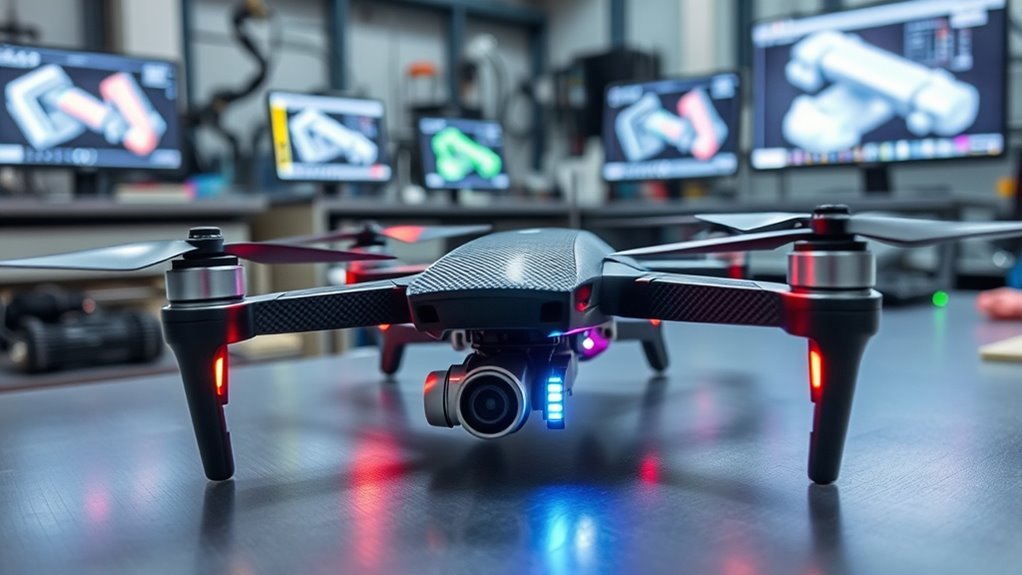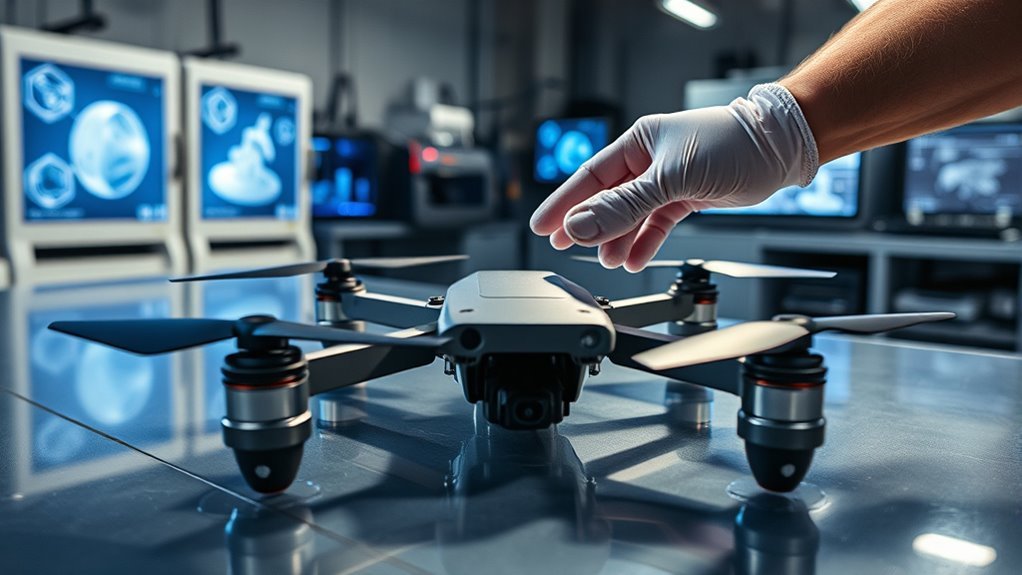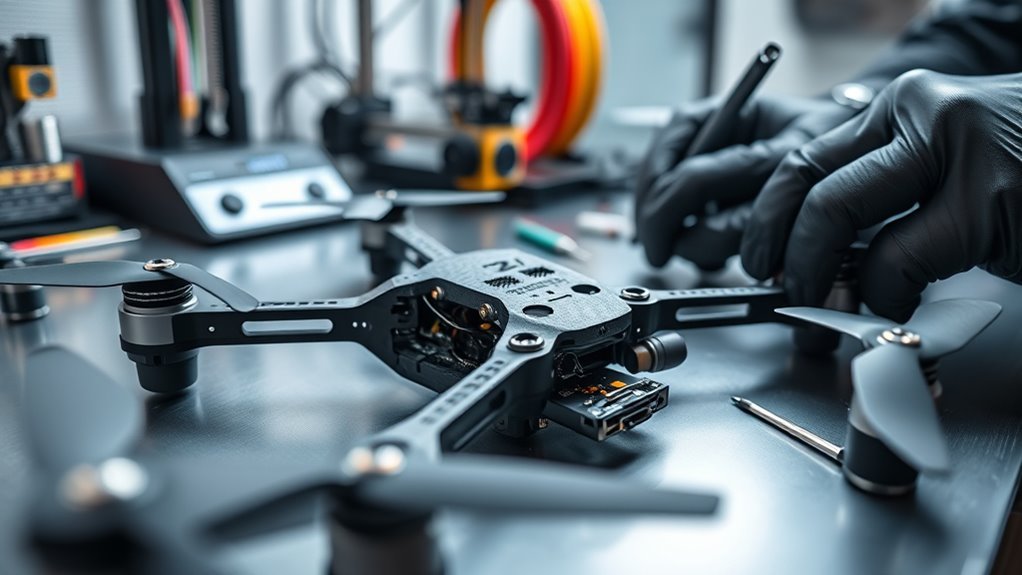Innovations in lightweight materials, like carbon fiber, enhance drone performance by improving strength-to-weight ratios. Next-generation propulsion systems, such as electric and hybrid technologies, reduce emissions and operational costs. AI plays an essential role in design optimization and predictive maintenance, improving reliability. The integration of sensors boosts navigation and data collection capabilities. 3D printing allows for rapid customization of designs, while enhanced battery technology guarantees longer flight times. There’s much more that can redefine drone manufacturing processes.
Advancements in Lightweight Materials

As drone technology evolves, advancements in lightweight materials play a crucial role in enhancing performance and efficiency. You’re likely aware that composite materials, such as carbon fiber and fiberglass, are revolutionizing drone manufacturing. These materials offer an ideal strength-to-weight ratio, enabling agile designs and extended flight times. With their ability to form intricate aerodynamic structures, drones can achieve superior lift and reduced drag, directly impacting their operational capabilities. By integrating advanced composite materials, manufacturers can create drones that not only withstand environmental stresses but also provide greater maneuverability. This shift towards lightweight construction empowers you, the operator, to explore new horizons in drone applications, from surveillance to delivery services, while maximizing energy efficiency and minimizing operational costs. Furthermore, incorporating advanced data encryption enhances the security of sensitive operations, ensuring that drone data remains protected during missions. Additionally, the use of reinforced composites in drones like the Yuneec Typhoon demonstrates how durability can be achieved without compromising on weight.
Next-Generation Propulsion Systems

As you explore next-generation propulsion systems, consider the impact of electric propulsion technologies on efficiency and performance. These systems promise reduced emissions and lower operational costs, making them attractive for various applications. Additionally, hybrid power solutions offer a versatile approach, combining the benefits of both electric and traditional fuels to enhance flight duration and reliability. Moreover, electric propulsion enables zero direct emissions, aligning aviation with ecological preservation for sustainable travel. Furthermore, the integration of advanced safety features in drone design enhances reliability and user confidence in autonomous operations.
Electric Propulsion Technologies
While traditional propulsion systems have dominated drone manufacturing for years, the emergence of electric propulsion technologies marks a transformative shift in the industry. These innovations leverage advancements in battery management to optimize energy usage, extending flight times and enhancing overall performance. With a focus on power density, electric motors deliver superior thrust-to-weight ratios, enabling drones to achieve greater agility and efficiency in flight. The integration of lightweight materials further complements these systems, reducing overall weight while maintaining durability. As you explore electric propulsion, consider how these technologies not only enhance operational capabilities but also contribute to sustainability goals. By adopting electric systems, you’re embracing a future where freedom of flight is redefined, empowering users to explore new horizons with greater autonomy.
Hybrid Power Solutions
Hybrid power solutions represent a significant advancement in drone propulsion systems, combining the strengths of electric and traditional fuel-based technologies. By leveraging hybrid energy, these systems enhance power efficiency, allowing drones to achieve longer flight times and extended ranges. You’ll find that hybrid configurations often integrate electric motors with combustion engines, optimizing energy use while reducing emissions. This approach not only provides the flexibility needed for various applications but also addresses the limitations of pure electric systems, particularly concerning battery life. With ongoing innovations, hybrid solutions are paving the way for more versatile drones, enabling them to operate in diverse environments and under challenging conditions. Ultimately, this technology reflects a commitment to maximizing performance and sustainability in drone operations.
The Role of AI in Drone Design

AI plays a critical role in enhancing design optimization for drones, allowing you to achieve superior aerodynamic efficiency and structural integrity. By utilizing predictive maintenance algorithms, these systems can anticipate failures and reduce downtime, increasing overall reliability. This integration of AI not only streamlines the design process but also enhances operational longevity in drone manufacturing. Moreover, advancements in real-time data processing enable drones to adapt dynamically to environmental changes, improving their overall performance and versatility. Additionally, EHang’s advanced AI algorithms contribute to minimizing human error and optimizing real-time decision-making, further enhancing drone capabilities.
Enhanced Design Optimization
As the demand for advanced drone capabilities increases, leveraging artificial intelligence in design refinement has become essential. AI facilitates aerodynamic modeling, allowing for simulations that predict performance in various conditions, enhancing efficiency and stability. By employing machine learning algorithms, designers can analyze vast datasets to identify ideal shapes and materials, minimizing weight while maximizing functionality. This user-centered design approach guarantees that drones meet specific operational needs, balancing performance and ease of use. With AI, iterative design processes become faster and more precise, enabling you to explore innovative configurations that traditional methods might overlook. Ultimately, integrating AI in drone design not only streamlines production but also empowers you to create more capable, adaptable, and user-friendly aerial vehicles.
Predictive Maintenance Algorithms
While drones continue to evolve in complexity and capability, implementing predictive maintenance algorithms has become essential for ensuring operational reliability and safety. These algorithms leverage data analysis to anticipate potential failures, allowing for proactive maintenance scheduling. You’ll find that:
- Real-time data collection enhances predictive accuracy.
- Historical performance data helps identify patterns and trends.
- Maintenance scheduling becomes more efficient, reducing downtime.
- Cost savings are realized through optimized resource allocation.
3D Printing and Customization
D printing has revolutionized drone manufacturing by enabling unprecedented levels of customization and complexity in design. With 3D printing, you’re empowered to create custom designs tailored to specific mission requirements. This technology allows for rapid prototyping, where you can iterate designs quickly, reducing time to market and enhancing innovation. You can experiment with materials and geometries that traditional methods can’t deliver. Additionally, innovations in smart systems enhance the adaptability of drones, allowing for more versatile applications across various industries. Furthermore, real-time data processing from drone operations can inform design choices, ensuring that new models meet operational demands effectively.
Here’s a quick comparison of 3D printing applications in drone manufacturing:
| Application | Benefits |
|---|---|
| Prototyping | Faster iterations |
| Custom Parts | Tailored functionality |
| Lightweight Frames | Improved flight efficiency |
| Specialized Components | Enhanced mission capability |
These advancements not only optimize performance but also promote a culture of creativity in drone design.
Enhanced Battery Technology
With the increasing demand for longer flight times and enhanced performance, innovations in battery technology are transforming the drone industry. You’ll find that advancements in battery life and charging infrastructure are key players in this evolution. These developments allow for extended operational capabilities and greater versatility for users.
Innovations in battery technology are revolutionizing the drone industry, enhancing flight times and operational versatility for users.
- Lithium-sulfur batteries promise higher energy density.
- Fast-charging systems reduce downtime considerably.
- Wireless charging pads facilitate on-the-go power replenishment.
- The integration of smart battery management systems enhances efficiency.
Additionally, advanced algorithms can optimize energy consumption during drone operations, further extending flight times. Together, these innovations enable drones to operate more freely and effectively, providing the autonomy you crave. As manufacturers push the boundaries, the potential for longer missions and improved performance keeps expanding, redefining what’s possible in drone applications. Additionally, breakthroughs in battery tech are improving efficiency without additional bulk, allowing for longer sessions without added weight.
Integration of Sensors and Automation
The advancements in battery technology are paving the way for more sophisticated drone applications, where the integration of sensors and automation plays a pivotal role. By employing sensor integration, drones can gather real-time data, enhancing their operational efficiency. This capability allows for improved navigation, obstacle detection, and environmental monitoring. Automation techniques, such as machine learning algorithms, enable drones to process this data seamlessly, making autonomous decision-making a reality. As you embrace these innovations, you’ll find that they not only extend flight times but also enhance safety and reliability. These technological advancements provide the freedom to explore new applications, from agriculture to surveillance, transforming how drones are utilized across various sectors. Additionally, the integration of multispectral cameras empowers drones to monitor crop health and infrastructure, further expanding their utility. Furthermore, thermal cameras can significantly improve the detection of heat signatures, enhancing situational awareness in low-visibility conditions. The future of drone technology is boundless.
Sustainable Manufacturing Practices
As manufacturers prioritize sustainability, implementing eco-friendly practices in drone production has become essential. By adopting sustainable manufacturing practices, you not only enhance the environmental impact but also improve your market competitiveness. Here are some key approaches to evaluate:
- Utilize eco-friendly materials, such as bioplastics and recycled composites.
- Implement green energy sources, like solar or wind power, in production processes.
- Reduce waste through efficient design and closed-loop systems.
- Optimize supply chains to minimize carbon footprints.
These strategies not only align with environmental goals but also resonate with consumers seeking responsible technology. By embracing sustainability, you contribute to a more sustainable future while maintaining the freedom to innovate and expand within the drone industry.
Frequently Asked Questions
How Do Drones Compare to Traditional Vehicles in Efficiency?
When you compare drones to traditional vehicles, you’ll find drones often excel in energy efficiency due to their aerodynamic design. This allows them to cover distances faster while consuming less energy, offering a more sustainable transportation option.
What Industries Benefit Most From Drone Innovations?
Picture drones as modern-day chariots; industries benefiting from their innovations include agriculture applications, delivery services, emergency response, construction monitoring, environmental conservation, film production, real estate marketing, and wildlife tracking, enhancing efficiency and reducing costs.
How Do Regulations Impact Drone Manufacturing?
Regulatory frameworks greatly impact drone manufacturing by imposing compliance challenges. You’ll need to navigate these regulations to guarantee safety and legality, which can influence design choices, production timelines, and ultimately, market competitiveness.
What Is the Lifespan of Modern Drone Components?
Modern drone components typically last several years, influenced by component durability and technology upgrades. You should consider factors like usage, maintenance, and environmental conditions to optimize their lifespan and enhance overall performance and reliability.
How Are Drones Tested for Safety and Reliability?
To guarantee safety and reliability, you’ll find drones undergoing rigorous flight simulations, adhering to strict safety standards. These tests evaluate performance under various conditions, confirming they meet necessary protocols before they’re cleared for operation.

